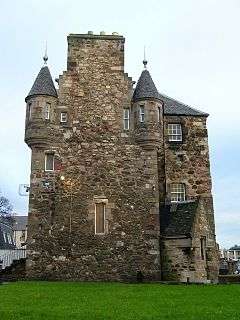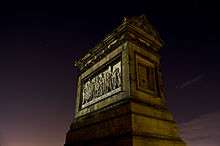Craigentinny
Craigentinny
| |
|---|---|
 Craigentinny House | |
| Council area | |
| Country | Scotland |
| Sovereign state | United Kingdom |
| Postcode district | EH |
| Dialling code | 0131 |
| Police | Scottish |
| Fire | Scottish |
| Ambulance | Scottish |
| EU Parliament | Scotland |

Craigentinny (Scottish Gaelic: Creag an t-Sionnaich) is a suburb in the north-east of Edinburgh, Scotland, east of Restalrig and close to Portobello.
Its name is a corruption of the Scottish Gaelic Creag an t-Sionnaich meaning "Foxrock" or Creag an teine meaning "Fire Crag".
History
Previously moorland, the first major house was built in 1604. This house, Craigentinny Castle (later renamed Craigentinny House), gives its name to the wider area. It was built by James Nisbet of the Nisbet family associated more strongly with the Dean area of the city, as the occupants of Dean House. The land was bought from the Logan family of Restalrig.[1] It was bought around 1760 by William Miller. In 1849/50 it was remodelled by David Rhind for Christie Miller, William Miller's great nephew (who gives his name to Christiemiller Avenue).[2]
In 1932 the Council developed part of the area with 520 houses and a block of six shops in three-storey tenements by Ebenezer James MacRae and his team.
The area contains churches and schools from the 1930s, including, Craigentinny Primary School on Loaning Road which was designed by Ebenezer James MacRae (1935), and St Christophers Church which is at the junction of Craigentinny Road and Craigentinny Avenue and was designed by James MacLachlan (1934).
The most distinctive and unique structure in the area is the mausoleum to William Henry Miller (1789–1848) by David Rhind dating from 1845 with world-class marble panels by Sir Alfred Gatley on all sides. This was subsumed by bungalows in the 1930s and now stands on Craigentinny Crescent. It is generally known as the Craigentinny Marbles.[3] Although it is sometimes written that William Henry Miller was sometimes called Christie,[4] Christie was the great nephew of William Henry. The confusion is compounded by a street near the monument being called Christiemiller Avenue, leading the monument to often be called the Christie Miller monument.
Ethnicity
| Craigentinny compared | Craigentinny | Edinburgh |
|---|---|---|
| White | 93.5% | 91.7% |
| Asian | 4.3% | 5.5% |
| Black | 0.9% | 1.2% |
| Mixed | 0.8% | 0.9% |
| Other | 0.5% | 0.8% |
Other features
Craigentinny Golf Course is an 18-hole par 67 course lying on the north edge of the district close to Seafield and the Firth of Forth.[5]
Craigentinny train maintenance depot is located in the area.
References
- ↑ "Home". Edinburgh Past And Present. Retrieved 11 February 2018.
- ↑ Buildings of Scotland: Edinburgh by Gifford, McWilliam and Walker
- ↑ Buildings of Scotland: Edinburgh, by Gifford, McWilliam and Walker
- ↑ "Craigentinny Marbles - a mausoleum in Craigentinny Crescent". edinphoto.org.uk. Retrieved 11 February 2018.
- ↑ "Craigentinny Golf Course :: Edinburgh Leisure". edinburghleisure.co.uk. Retrieved 11 February 2018.
Coordinates: 55°57′31.94″N 3°7′58.07″W / 55.9588722°N 3.1327972°W
